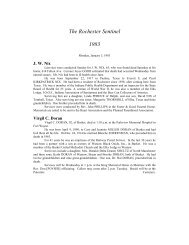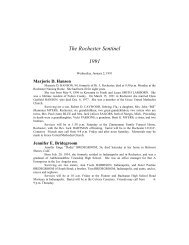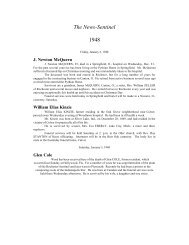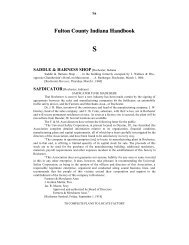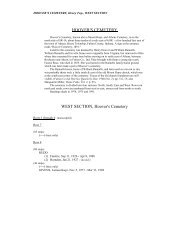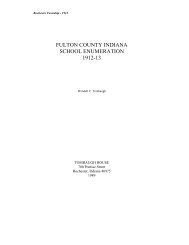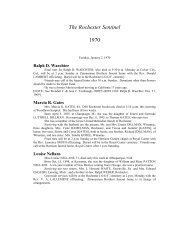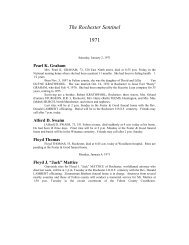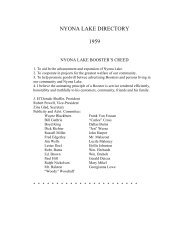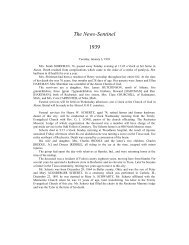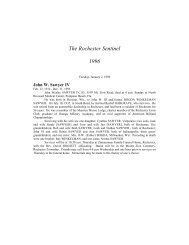Handbook N-P - Fulton County Public Library
Handbook N-P - Fulton County Public Library
Handbook N-P - Fulton County Public Library
Create successful ePaper yourself
Turn your PDF publications into a flip-book with our unique Google optimized e-Paper software.
Ol<br />
following the wheat harvest from Manitoba to Oklahoma and working as a fire tender on the Erie-<br />
Lackawana Railroad.<br />
When the U.S. government offered young teachers the opportnity to apply for positions<br />
in the Philippine Islands, then an American protectorate gained in reparation from Spain after the<br />
Spanish-American War, he saw a teaching opportunity that would satisfy his wanderlust. Making<br />
the offer even better was the compensation--$90 per month, outbound and inbound transportation<br />
to the States every three years and guaranteed full-time employment plus incentives. Not realizing<br />
he would spend 35 years in the archipelago still partially populated by headhunters and in dire<br />
need of schools, he headed for the Far East.<br />
En route, his ship stopped in Yokohama, Japan, and, according to a letter he wrote his<br />
mother, he planned to see Tokyo and Kyoto before making his way around the peninsula to<br />
Nagasaki so he could rejoin his ship when it docked. He estimated that by riding the narrow<br />
gauge trains, hiking, taking horse-drawn carriages and a Japanese version of rickshaws, he could<br />
make the trip in three days. “That adventurism was typical,” says his son Jim.<br />
“He didn’t know the transportation modes available, nor the condition of the roads and<br />
railroads; he just knew what he was going to do. He was a stranger in a strange land who didn’t<br />
even know where he was going to sleep at night. He just knew he’d figure out a way.”<br />
Over the next 28 years, armed with a smattering of Spanish, German and the Visayan and<br />
Tagalog languages of the Central and Southern Philippines, he advanced from high school<br />
principal to school superintendent in four successive provinces and figured out a way to organize<br />
127 schools. It was work he thoroughly enjoyed. “I’ve been in the business so long I doubt if I<br />
could be satisfied teaching my own people,” he wrote his brother.<br />
In his spare time, he traveled--mostly by tramp steamer--to Hong Kong, mainland China,<br />
Macao, Manchuria and Singapore. On one trip, he bargained to shovel coal in the boiler room of a<br />
rusty ship in order to get back to his teaching job. The only Occidental among Chinese coolies<br />
blackened by months of exposure to coal dust, he had to admit it was very hot, hard work.<br />
But the man who remained fearless, even when wanted “dead or alive,” had a weakness.<br />
“I was a Jonah’s Whale all the way,” he told his brother, using his favorite euphemism for<br />
seasickness, an affliction he never conquered.<br />
On land and with camera in hand, he traversed much of the Philippines, stopping to visit<br />
the Igorot tribe in Bontoc Province. “They’re cannibalistic,” he reported, “but only against enemy<br />
tribes.” He hied the dangerous Benquet Road, “just for the experience” and watched dogs being<br />
beaten to death, then eaten.<br />
“He used to hike the interior of Luzon, from one headhunters’ tribal territory to another,”<br />
Jim Oliver recalls. “Why someone didn’t kill him for making friends with everybody, including<br />
enemy tribes, I don’t know.”<br />
Also a commissioned officer with the U.S. Army, he organized 128 companies (about<br />
1,200 men) of young trained military cadets in a period between 1918 and 1933 that provided<br />
future soldiers for the Philippine Constabulary, the genesis of today’s Philippine army. By 1920,<br />
he was able to write to his brother, “We find that military drill is very beneficial to students,<br />
particularly when the Army calisthenics are given! The boys like to parade.”<br />
While working in Iloilo, he met Flora Carbonell, an educator who had been appointed<br />
Supervisor of Normal Schools in southern Mindanao, one of the two largest of the Philippines’<br />
7,100 islands. The U.S. educator was fascinated by the young woman of Filipino-Spanish descent,<br />
but the contrast between them was vivid.<br />
He had no roots except for family ties in Indiana; her philosophy was to be grounded with<br />
an established home in a nice area, various investments, including a second home in Davao City<br />
and a small plantation in rural Mindanao.<br />
Refined in the Old World manner, she loved opera and symphonic music. Jungle-smart<br />
and resourceful, he possessed a streak of adventure that would strike fear in most men. But they<br />
shared many similar qualities, mostly in regard to education, and a romance blossomed.<br />
They traveled together to the States in 1933, he for further study at Indiana University,<br />
she to obtain a master’s degree in English at the University of Chicago. By the time they returned




